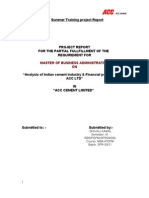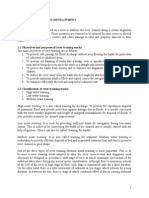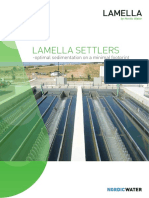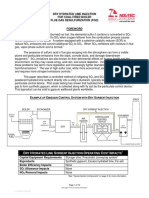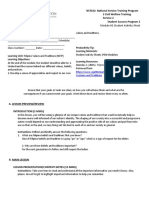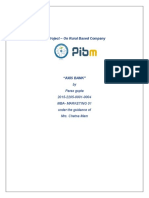0 ratings0% found this document useful (0 votes)
87 viewsHobas Sand Trap e
Hobas Sand Trap e
Uploaded by
khaimatsahThe sand trap is a key component of small hydropower systems that removes solids from river water before it reaches the penstock and turbine. It uses a stilling chamber to reduce the water's flow velocity, allowing sediments like sand and gravel to settle in the settling chamber. A flushing system then rinses the collected solids out of the sand trap through a flushing pipe without disrupting power generation. HOBAS has developed an effective prefabricated sand trap made of glass fiber reinforced pipes that is easy to transport and install.
Copyright:
© All Rights Reserved
Available Formats
Download as PDF, TXT or read online from Scribd
Hobas Sand Trap e
Hobas Sand Trap e
Uploaded by
khaimatsah0 ratings0% found this document useful (0 votes)
87 views3 pagesThe sand trap is a key component of small hydropower systems that removes solids from river water before it reaches the penstock and turbine. It uses a stilling chamber to reduce the water's flow velocity, allowing sediments like sand and gravel to settle in the settling chamber. A flushing system then rinses the collected solids out of the sand trap through a flushing pipe without disrupting power generation. HOBAS has developed an effective prefabricated sand trap made of glass fiber reinforced pipes that is easy to transport and install.
Original Description:
free for download
Copyright
© © All Rights Reserved
Available Formats
PDF, TXT or read online from Scribd
Share this document
Did you find this document useful?
Is this content inappropriate?
The sand trap is a key component of small hydropower systems that removes solids from river water before it reaches the penstock and turbine. It uses a stilling chamber to reduce the water's flow velocity, allowing sediments like sand and gravel to settle in the settling chamber. A flushing system then rinses the collected solids out of the sand trap through a flushing pipe without disrupting power generation. HOBAS has developed an effective prefabricated sand trap made of glass fiber reinforced pipes that is easy to transport and install.
Copyright:
© All Rights Reserved
Available Formats
Download as PDF, TXT or read online from Scribd
Download as pdf or txt
0 ratings0% found this document useful (0 votes)
87 views3 pagesHobas Sand Trap e
Hobas Sand Trap e
Uploaded by
khaimatsahThe sand trap is a key component of small hydropower systems that removes solids from river water before it reaches the penstock and turbine. It uses a stilling chamber to reduce the water's flow velocity, allowing sediments like sand and gravel to settle in the settling chamber. A flushing system then rinses the collected solids out of the sand trap through a flushing pipe without disrupting power generation. HOBAS has developed an effective prefabricated sand trap made of glass fiber reinforced pipes that is easy to transport and install.
Copyright:
© All Rights Reserved
Available Formats
Download as PDF, TXT or read online from Scribd
Download as pdf or txt
You are on page 1of 3
h Sand Trap
for Small Hydropower Plants
4
2
5
7
8
9
3
6
1
5
6
The sand trap is a key component for removing solids in small hydro-
power systems. After large stones and woody debris are held back by a
screen at the weir, the sand trap separates smaller solids such as gravel,
sand and silt from the river water. It thereby prevents sedimentary depos-
its from building up in the penstock. This, in turn, extends the hydropower
plants operating time and maintenance intervals, protects the turbine
from excessive wear and increases the facilitys service life.
HOBAS has developed a particularly effective, prefabricated sand trap
which is built out of glass fber reinforced pipes. Thanks to the precast
units and low weight, the HOBAS Sand Trap is transported to the installa-
tion site and integrated into the power plant system very easily. A fushing
unit, which can be fully automated on request, reliably cleans the sand
trap from separated solids.
6 Flushing Pipe (automatable)
The solids are then rinsed out of the sand trap
through a fushing pipe that is opened for this
purpose. On request, special sensors are inte-
grated to control the fushing automatically. The
turbine does not need to be turned off during
the fushing process. This ensures the continous
generation of hydroelectric energy.
9 Outlet Pipe to Penstock
The cleaned river water exits the sand trap
through an outlet pipe which is connected to the
penstock. The penstock then conveys the water
to the power house.
1 Inlet Pipe
After the river water has passed the screen and
is thereby cleaned of large solids, it enters the
sand trap through an inlet pipe.
3 Stilling Slats
The settling of solids is increased by factory-
mounted vertical slats. They calm turbulence
in the fow, especially that perpendicular to the
direction of fow.
h Sand Trap
Reliable Separation of Solids at Small
Hydropower Plants
5 Sedimentation System
The particles collect in the sedimentation sys-
tem inside the settling chamber. The HOBAS
Sand Trap is designed in a way to prevent the
settled solids from being stirred up and re-intro-
duced into the water very effectively.
7 Inspection Opening
The sand trap can be accessed through a
factory-mounted HOBAS GRP Inspection Man-
hole that is equipped with a manhole cover. The
accessibility of sand traps with larger structural
lengths can be improved by means of additional
manholes.
2 Stilling Chamber
A cross-sectional enlargement in the frst part of
the sand trap reduces the fow velocity consider-
ably. This way, solids can subsequently settle.
4 Settling Chamber
As an effect of the water's reduced fow veloci-
ty, the solids sink down to the bottom of the
settling chamber, right into the integrated sedi-
mentation system.
Advantages h Sand Trap
O Reliable separation of solids
O Effective fushing system for the safe removal
of sediments from the sand trap
O Unhindered operation of the turbine during
the fushing process
O Easy mounting thanks to prefabricated units
O Little space and excavation required during
installation
O Individual design for optimal performance
O Easy handling thanks to low weight
O Installation in remote areas possible
How the HOBAS Sand Trap works
The coarsely cleaned river water enters the sand
trap through an inlet pipe. Due to the stilling
chamber's cross-sectional enlargement, the wa-
ter fow velocity decreases and turbulence in the
fow is reduced. Vertical stilling slats aid the wa-
ter fow stabilization. In the settling chamber, the
solids sink down into the sedimentation system
and are then rinsed out of the sand trap through
a fushing pipe, which can be opened for this
purpose. Special sensors to automate the
fushing can be integrated on request. During
the fushing process, the turbine continues to
operate unhindered, ensuring continuous power
generation and maximal plant exploitation.
The optimal settling system and the effcient
fushing function of the HOBAS Sand Trap have
been proven and verifed by means of a numeri-
cal simulation model at the VUT Prague (Czech
Technical University in Prague) and a hydraulic
model at the BOKU Vienna (University of Natural
Resources and Life Sciences in Vienna).
Each HOBAS Sand Trap is custom-tailored to
the given requirements with regard to numer-
ous factors, including the solids size and settling
times as well as the inlet fow velocity of the
water. This guarantees the best possible settling
and fushing performance of the sand trap and
an optimal long-term performance of the hydro-
power plant.
8 Overfow Plate
A tilted overfow plate at the end of the sand trap
ensures that the suction of the outlet pipe can-
not rinse out the settled solids into the penstock.
No part of this document may be reproduced or utilized in any form or by any means without our prior written permission. All information in the document
is correct at the time of going to press. However, we reserve the right to make changes without notice, in particular to technical data. The data given is not
binding and must therefore be checked in each individual case and revised as appropriate.
E Group Worldwide
HOBAS manufactures and markets HOBAS GRP Pipe
Systems. The HOBAS Network includes HOBAS Production
Facilities and Sales Organizations in Europe and throughout
the world.
E Engineering Austria
Pischeldorfer Strasse 128
9020 Klagenfurt | Austria
T +43.463.48 24 24 | F +43.463.48 21 21
info@hobas.com | www.hobas.com
Publication: 09/2013
When developing and manufacturing HOBAS Products, we are dedicated to
conserving resources and respecting the environment. Visit our website to
fnd out more about the HOBAS Environmental Policy.
You might also like
- GEORGE BERNARD SHAW On Islam PDFDocument18 pagesGEORGE BERNARD SHAW On Islam PDFIslamicfaith Introspection84% (19)
- Cheat Sheet StaticsDocument1 pageCheat Sheet Staticschanttel100% (1)
- What Every Engineer Needs To Know About Vacuum Insulated TubingDocument8 pagesWhat Every Engineer Needs To Know About Vacuum Insulated TubingitmrepsNo ratings yet
- The Backacter: Transportation of Excavator Section Towards SlipwayDocument5 pagesThe Backacter: Transportation of Excavator Section Towards SlipwayAditi BazajNo ratings yet
- Shortcut Nitrogen Removal-Nitrite Shunt and DeammonificationFrom EverandShortcut Nitrogen Removal-Nitrite Shunt and DeammonificationNo ratings yet
- Wash ThroughDocument0 pagesWash ThroughWan MahiramNo ratings yet
- Free Eth ScriptDocument5 pagesFree Eth Scriptk0lanNo ratings yet
- Project Report in FinanceDocument53 pagesProject Report in Financeshivali_kamal462275% (36)
- Name: Stephany Kwoyiga INDEX NUMBER: UEB0506118Document3 pagesName: Stephany Kwoyiga INDEX NUMBER: UEB0506118Musah HarunaNo ratings yet
- Disclosure To Promote The Right To InformationDocument10 pagesDisclosure To Promote The Right To InformationgayalamNo ratings yet
- Slurry Wall PDF 02Document15 pagesSlurry Wall PDF 02Syufri HakimNo ratings yet
- Transient AnalysisDocument3 pagesTransient Analysissamsurendran_mech4020No ratings yet
- Hydraulic Structures II-1Document51 pagesHydraulic Structures II-1ace1205100% (2)
- Chapter 6Document33 pagesChapter 6rahulNo ratings yet
- Shallow Tube Well-Model.2pdfDocument1 pageShallow Tube Well-Model.2pdfIhd ConsultancyNo ratings yet
- Managing Ground Water Quality andDocument14 pagesManaging Ground Water Quality andErwin AnshariNo ratings yet
- Trade Logistics Facilitation Key To CompetitivenessDocument13 pagesTrade Logistics Facilitation Key To CompetitivenessKenneth TiongNo ratings yet
- Wavin Tegra 600 Data SheetDocument2 pagesWavin Tegra 600 Data SheetshivamNo ratings yet
- Sediment Removal TechnologyDocument20 pagesSediment Removal TechnologyguildkeyNo ratings yet
- 1.0 FourPhase Sand TrapDocument2 pages1.0 FourPhase Sand TrapTg TarroNo ratings yet
- ONGC Report First Pit Less Drilling in ONGC Scripts Success at RajahmundryDocument6 pagesONGC Report First Pit Less Drilling in ONGC Scripts Success at RajahmundryPETROPATH FLUIDS INDIA PVT. LTD.No ratings yet
- SR 34 PDFDocument139 pagesSR 34 PDFMohamedNo ratings yet
- Optimal Design of A Sewer Line Using Linear ProgrammingDocument10 pagesOptimal Design of A Sewer Line Using Linear ProgrammingYugs AryaNo ratings yet
- S1301 Lamella Brochure EN 1Document8 pagesS1301 Lamella Brochure EN 1Yoto Gómez MosqueraNo ratings yet
- 1 Building Const 1Document38 pages1 Building Const 1ashleyane garlanNo ratings yet
- Sand Trap LiteratureDocument237 pagesSand Trap LiteratureBop AlberthaNo ratings yet
- Storm Water Management Design Manual Culverts and BridgesDocument14 pagesStorm Water Management Design Manual Culverts and Bridgesfox360No ratings yet
- Intake SystemDocument4 pagesIntake Systempramodtry100% (1)
- Lesson 7 Construction Dewatering and Ground FreezingDocument17 pagesLesson 7 Construction Dewatering and Ground FreezingRsjBugtongNo ratings yet
- Piano Key Spillway For DamsDocument22 pagesPiano Key Spillway For DamsMahaManthra75% (4)
- ASDSO Seepage Presentation - Day 2C - Seepage Control Methods PTDocument13 pagesASDSO Seepage Presentation - Day 2C - Seepage Control Methods PTMUHAMMAD ALINo ratings yet
- WWTP Mardan 1st PhaseDocument41 pagesWWTP Mardan 1st Phasemohammad armaghan100% (1)
- Rock Catchment Dam With Self-Closing WatertapDocument90 pagesRock Catchment Dam With Self-Closing WatertapGreen Action Sustainable Technology GroupNo ratings yet
- Refinery Wastewater Management Using Multiple Angle Oil Water Separators PDFDocument24 pagesRefinery Wastewater Management Using Multiple Angle Oil Water Separators PDFBihina HamanNo ratings yet
- Gas Production Gathering NetworkDocument9 pagesGas Production Gathering NetworkVhaieNo ratings yet
- Drainage: Definition of TermsDocument14 pagesDrainage: Definition of TermsJenny ValderramaNo ratings yet
- Geotubes Catalog 完整Document12 pagesGeotubes Catalog 完整Mg. Kaung100% (1)
- Barsha Pump - HDocument3 pagesBarsha Pump - HZak To100% (1)
- Sorbent - Injection Line InjectionDocument10 pagesSorbent - Injection Line InjectionmadyaNo ratings yet
- Johnson Seminar ProjectDocument19 pagesJohnson Seminar ProjectsiriuslotNo ratings yet
- SOP For Flushing of Mixed Bed PolisherDocument5 pagesSOP For Flushing of Mixed Bed PolisherMuhammad Haris HamayunNo ratings yet
- Development Chalenges For Indian AgricultureDocument260 pagesDevelopment Chalenges For Indian AgricultureAction for Food Production100% (1)
- CofferdamDocument3 pagesCofferdamRajesh KhadkaNo ratings yet
- Spillways and Flood Control Structures PDFDocument15 pagesSpillways and Flood Control Structures PDFAhmed BalahNo ratings yet
- Deposition Velocity EstimationDocument179 pagesDeposition Velocity EstimationGlawenClattucNo ratings yet
- Bentley Water SolutionsDocument31 pagesBentley Water SolutionsAnonymous 1UYC6pNo ratings yet
- Spe 110975 MSDocument11 pagesSpe 110975 MSAndre YudhistiraNo ratings yet
- Reelwell Drilling Method Makes Use of Dual Conduit Drill StringDocument2 pagesReelwell Drilling Method Makes Use of Dual Conduit Drill Stringlulalala8888100% (1)
- 4 Hydraulic Design: (For Design Storm Volume of Storm Sewer See Section 3.2 On Page 22)Document15 pages4 Hydraulic Design: (For Design Storm Volume of Storm Sewer See Section 3.2 On Page 22)Syazwan AbhNo ratings yet
- Design Example 06Document187 pagesDesign Example 06lqdpr0% (1)
- AXMSummary BFSOU FinalReportMar17Document126 pagesAXMSummary BFSOU FinalReportMar17Santiago TazónNo ratings yet
- Constn Tools & EquipmentDocument26 pagesConstn Tools & EquipmentAdrian Kyle FernandezNo ratings yet
- Halliburtos SAND TRAPDocument2 pagesHalliburtos SAND TRAPAnonymous JdPYHGmW100% (1)
- Hydraulic Design of DesiltersDocument7 pagesHydraulic Design of DesiltersRajpNo ratings yet
- Excel-Solution of The Implicit Colebrook Flow Friction EquationDocument14 pagesExcel-Solution of The Implicit Colebrook Flow Friction EquationLasandu WanniarachchiNo ratings yet
- Product-Sheet Filter NTF DIGITALDocument2 pagesProduct-Sheet Filter NTF DIGITALNduong NguyenNo ratings yet
- IntakesDocument16 pagesIntakesRamsharan DhakalNo ratings yet
- Lecture Ce447Document107 pagesLecture Ce447Saqib imranNo ratings yet
- 5 Dissolved Air Flotation (DAF) For Wastewater Treatment: August 2017Document39 pages5 Dissolved Air Flotation (DAF) For Wastewater Treatment: August 2017mms2007No ratings yet
- Paste Thickener Design and Operation Selected To Achieve Downstream RequirementsDocument23 pagesPaste Thickener Design and Operation Selected To Achieve Downstream RequirementsAlfredo CollantesNo ratings yet
- PDS Pro Struct 618LV October 2017 Replaces January 2014Document2 pagesPDS Pro Struct 618LV October 2017 Replaces January 2014Amar Babu ChNo ratings yet
- ASCE Paper PDFDocument8 pagesASCE Paper PDFLeandroNo ratings yet
- MOZLEY Wellhead DesanderDocument2 pagesMOZLEY Wellhead DesanderYosmar GuzmanNo ratings yet
- 100% Scheduling Case StudyDocument48 pages100% Scheduling Case StudySeanElverdNo ratings yet
- Journal of Eurasian Studies 6Document10 pagesJournal of Eurasian Studies 6Pheourn ChhannyNo ratings yet
- TCW Chapter 7Document16 pagesTCW Chapter 7Lanestosa Ernest Rey B.No ratings yet
- Pronombresobjetoe1 EXAMEN INGLES PDFDocument2 pagesPronombresobjetoe1 EXAMEN INGLES PDFAna Maria Cadenas GuerreroNo ratings yet
- LIBRETTO Volume 1: Vampirism PreviewDocument10 pagesLIBRETTO Volume 1: Vampirism PreviewGraphic PolicyNo ratings yet
- Advanced Unit Test 4: Grammar VocabularyDocument2 pagesAdvanced Unit Test 4: Grammar VocabularyAlinaNo ratings yet
- CS Sample PaperDocument3 pagesCS Sample PaperAbhishekNo ratings yet
- Air Canada V CirDocument15 pagesAir Canada V CirArmstrong BosantogNo ratings yet
- Aria Melinda Luisa R. Lariosa: OBJECTIVE:: Seeking A Challenging Career ThatDocument3 pagesAria Melinda Luisa R. Lariosa: OBJECTIVE:: Seeking A Challenging Career ThatryuggaNo ratings yet
- 103E. Supplier Evaluation Checklist For Externally Provided CalibrationDocument4 pages103E. Supplier Evaluation Checklist For Externally Provided CalibrationVikasNo ratings yet
- BUENAGUA Aguirre V PhengDocument1 pageBUENAGUA Aguirre V PhengMartin Benjamin Tomelden LagmayNo ratings yet
- Middle 140319Document15 pagesMiddle 140319BernewsAdminNo ratings yet
- Philosophical InquiryDocument9 pagesPhilosophical InquiryJerome FaylugaNo ratings yet
- Sas2 - Filipino Values and TraditionsDocument5 pagesSas2 - Filipino Values and TraditionsCharlene MananapNo ratings yet
- Narrative Text: Name: - ClassDocument2 pagesNarrative Text: Name: - ClassIsna Nur Islamiyah100% (1)
- GST On E-Commerce OperatorsDocument45 pagesGST On E-Commerce OperatorsSai Kiran KudavalliNo ratings yet
- Team A Case 1 - Satera CaseDocument4 pagesTeam A Case 1 - Satera CaseJúlia Moura CardosoNo ratings yet
- Mini Project - On Rural Based CompanyDocument21 pagesMini Project - On Rural Based CompanyShivam JadhavNo ratings yet
- Fixed Income Markets and Products: 5 - Bond Investment StrategiesDocument13 pagesFixed Income Markets and Products: 5 - Bond Investment StrategiesUday ChaudhariNo ratings yet
- Federal Register PostDocument4 pagesFederal Register PostThe Western JournalNo ratings yet
- Introduction To Bpo: F.Y. Bcom - Banking and Insurance 1Document29 pagesIntroduction To Bpo: F.Y. Bcom - Banking and Insurance 1Mitali MehtaNo ratings yet
- Bibliograph 1Document7 pagesBibliograph 1api-189354721No ratings yet
- Area Yang TerbatasDocument1 pageArea Yang TerbatasFaisal FauzanNo ratings yet
- Rosa Bonheur PDFDocument10 pagesRosa Bonheur PDFIolandaTomiucNo ratings yet
- Soal Latihan Bahasa Inggris Kelas 2Document3 pagesSoal Latihan Bahasa Inggris Kelas 2Dash Da Gomez0% (2)
- No.39 E 96Document2 pagesNo.39 E 96Fatu KromahNo ratings yet
- The Lament - 20240514 - 164942 - 0000Document14 pagesThe Lament - 20240514 - 164942 - 0000jolo Del Rosario GeneraoNo ratings yet







